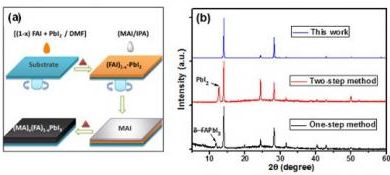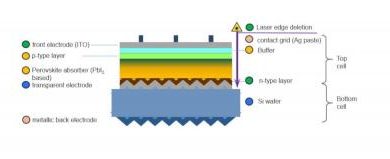New quality control method could help scale up perovskite solar cells

Researchers from Australia’s ARC Center of Excellence in Exciton Science, Monash University, Wuhan University of Technology and CSIRO Energy have shown how critical imperfections invisible to the naked eye can be detected by shining blue light onto the cells and recording the infrared light that bounces back.
 Perovskite solar cells bathed in blue light, and responding in infrared. Credit: Exciton Science
Perovskite solar cells bathed in blue light, and responding in infrared. Credit: Exciton Science
This “trick of the light” may help detect imperfections in perovskite solar cells, opening the door to improved quality control for commercial production.
When attempting to scale up perovskite cells, performance often deteriorates due to nanoscale surface imperfections resulting from the way the materials are made. As the number of detects grows, the amount of solar power generated per square centimeter drops.
Now,the Australian research team has come up with a possible solution – using a camera. The technique employs a property of solar cells called “photoluminescence”. This is the process by which an electron inside a molecule or semiconductor is briefly powered-up by an incoming photon. When the electron returns to its normal state, a photon is spat back out.
Microscale flaws alter the amount of infrared produced. Analyzing how the extent of the light emitted from the solar cell varies under different operating conditions gives clues to how well the cell is functioning.
“Using this technique, we can rapidly identify a whole range of imperfections,” said Dr. Rietwyk, an Exciton Science researcher based at Monash University and first author of the new paper. “We can then figure out if there are enough of them to cause a problem and, if so, adjust the manufacturing process to fix it. It makes for a very effective quality control method.”
Equivalent checking methods are common in silicon cell manufacture. By employing an innovative light modulation, Dr. Rietwyk and colleagues have designed a new approach that rises to the challenges posed by next-gen cells – opening a pathway to a scalable and potentially commercial device.
Senior author Professor Udo Bach, also of Exciton Science and Monash University, said the team had performed successful test runs on batches of small research cells. The technology, he explained, will be simple to scale up and commercialize.
“This research shows clearly that the performance of perovskite solar cell devices is influenced by the number of small imperfections in the cells themselves,” he said.
“Using light modulation to find these flaws is a quick and robust way to solve the problem – and one that should work on any level of production.”
Nano EnergyEurekalertPerovskite applicationsPerovskite SolarTechnical / researchEfficiency
Above are New quality control method could help scale up perovskite solar cells web publication,Hope can help you.


